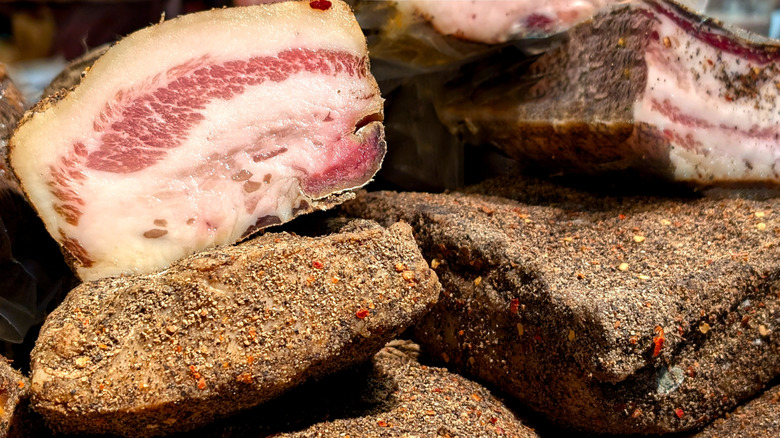You Don't Need Much To Cure Meat At Home
We may receive a commission on purchases made from links.
Cured meat always seems like it came straight from the food factory, complete with plastic packaging. Italian cold cuts, Spanish-style chorizo (as opposed to the uncured Mexican kind), and bacon (even the uncured kind is cured) – not one of these seems like a DIY project. Still, what about all those hipster restaurants promising house-made charcuterie? Is this another marketing lie, or do they have some elaborate meat manufacturing setup back in the kitchen? Neither one need be true, since, surprisingly enough, you actually can cure meat at home without fancy equipment. K.C. Gulbro, proprietor of the Illinois eatery FoxFire Steakhouse, was helpful enough to explain the process to us. Turns out, it doesn't involve too many special ingredients, either.
The primary ingredients are meat and salt, with Gulbro describing the latter as "the main curing agent that draws out moisture and inhibits microbial growth." Although salt used to be the only curing agent back in the day, today's curing recipes typically call for nitrites, as well. If you're looking to purchase this ingredient, it'll typically be labelled as curing salt. Gulbro noted that celery powder can be used since it contains nitrites naturally. Nitrites, as he explained them, "prevent growth of Clostridium botulinum and help with color and flavor." Seasonings such as pepper or garlic are optional.
There are two other necessities for proper meat curing. One is a scale for weighing the ingredients because, according to Gulbro, "Curing ratios must be exact for safety." The other necessity is enough space in the fridge for the meat to chill undisturbed while it cures.
Tips for successful home curing
There are five different curing methods: dry curing, where the meat is submerged in salt; equilibrium curing, which uses a lot less salt (just 3% of the meat's weight) but requires the meat be vacuum-sealed; brine curing, which involves either soaking the meat in salt water or injecting the brine directly; combination curing, which involves both a brine injection and a surface salt rub; and sausage curing, wherein salt and other seasonings are mixed directly into ground meat. No matter which method you use, Gulbro urged, "Choose a tested recipe to ensure safe ratios of salt, nitrite, and time." The testing should be performed by either the USDA or an extension service.
Gulbro emphasized the need to sanitize your hands along with any utensils and cutting boards used in order to avoid cross-contamination. He also reiterated the importance of using a scale, explaining, "Too much nitrite can be toxic; too little can fail to protect against harmful bacteria." If your curing method involves applying a rub to the meat's surface, be sure to cover it evenly. Not only will any missed spots affect the favor, but they might also breed bacteria. You'll also need to refrigerate the meat while it cures to keep it from spoiling, and allow it to cure for the full amount of time specified in the recipe. This, Gulbro said, "ensures the salt and nitrites penetrate fully for preservation, flavor, and color." Depending on the curing method, you may also need to rinse and dry the meat as a final step. According to Gulbro, "This controls saltiness and sets up meat for cooking or smoking."

